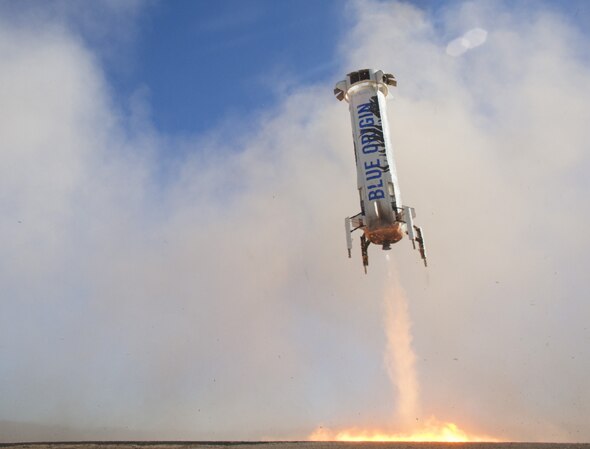Create a free profile to get unlimited access to exclusive videos, sweepstakes, and more!
Blue Origin: Third Time’s a Charm (but So Were the First and Second)

Over the weekend, on Saturday, the private rocket company Blue Origin did it again, again: For the third time it launched the New Shepard rocket on a suborbital flight, reaching a height of more than 100 kilometers (the generally accepted line demarking a trip into space), and brought it back safely to Earth again.
To be clear: It was the same rocket for all three flights. That’s fantastic news!
The first flight above the 100 kilometer mark (called the Kármán line) was in November of 2015, and the second in January 2016. There had been some earlier tests at lower altitudes as well.
According to Blue Origin CEO Jeff Bezos’ tweets, it all went smoothly. The rocket soared into the sky, deployed the (uncrewed) crew capsule, then fell back to Earth. They then tried something new: The rocket engine was off during most of the descent, and then did a “quick restart” at a mere 1,000 meters above the ground! It fired up rapidly and brought the booster down to the ground safely. Blue Origin has the video highlights of the mission:
I can't believe how close to the ground the engine was when they restarted it. Consider my hair raised.
Not only that, but two scientific experiments were on the crew capsule; one was to see how dust aggregates in microgravity (as a precursor to understanding how planets form).
And the other? It was a “box rocks,” designed to test how rocks and smaller material (called “regolith”) behave in microgravity, an important step in seeing how the very low gravity on the surfaces of asteroids sorts that material. This experiment was crated at the Southwest Research Institute, and I’m very pleased to note it’s the brainchild of my old friend Dan Durda!
Dan and SwRI are very serious about suborbital science, as well they should be.
Mind you, the New Shepard rocket didn’t go into orbit; it went up and then back down again. But the capsule experiences free fall for about three to four minutes, which is enough time to do a lot of science if you’re clever. I’m very happy to see Blue Origin doing this; it’ll be a while before it can put humans in its capsule, and in the meantime a lot of good work can be done when it does test flights like this one. My friend Alan Boyle has more over at Geekwire, including some videos taken by onlookers.
It’s very exciting to see a new age of reusable rocket tech really starting to come into its own. I’ll note that they’re also working on a new engine, the BE-4. This is a powerful engine, and Blue Origin has partnered with United Launch Alliance to use it in an upgraded Atlas V rocket, which currently uses the Russian RD-180 engine. That has been the source of some controversy, so it’s very good indeed to see them moving away from dependence on Russia.
Congratulations to Blue Origin on all its success!














